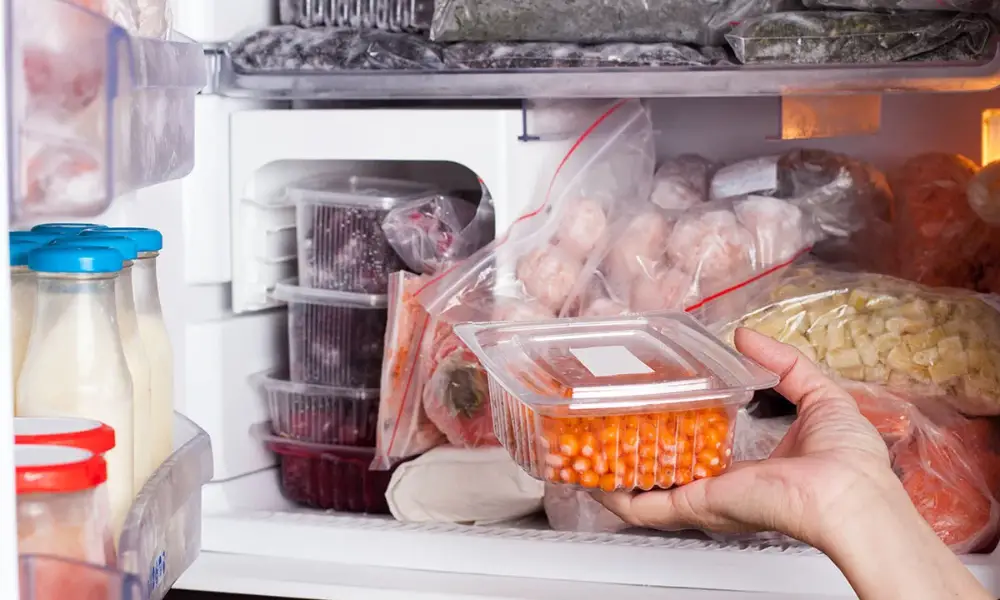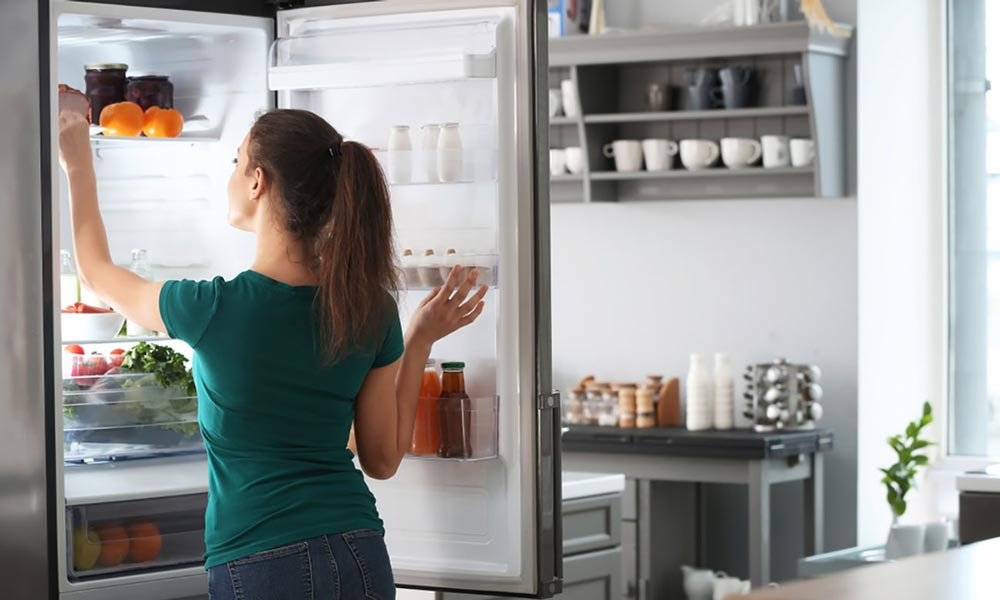If you’ve ever wondered what to do with food when defrosting your freezer, you’ve come to the right place. You’ll find tips on keeping perishable foods cold and cleaning the inside of your freezer. Plus, you’ll learn how to avoid food poisoning and properly store your frozen foods.
Most recent refrigerators and freezers do not require manual defrosting because they are frost-free. There is no getting around the necessity to defrost a fridge freezer if it has solidified into a huge block of ice, though.

What is a Freezer Defrost?
Defrosting a freezer is getting rid of the accumulation of ice that can develop over time on the walls, shelves, and coils of a freezer. The effectiveness of the freezer may be decreased as a result of the ice building, and it may also be more challenging to reach and arrange the food inside.
When defrosting a freezer, it is necessary to cut off the power, remove all the contents, and wait for the ice to melt. You may do this manually by leaving the door open and scraping the ice off with a warm towel or a scraper, or you can do it automatically by turning on the built-in defrost system. After the ice is taken out, the freezer should be cleaned and dried before being turned back on and filled with food.
What to do with Food When Defrosting your Freezer?
All frozen products must be taken out of your freezer and put in a cooler or insulated bag with ice packs to maintain a safe temperature while your freezer is being defrosted. Foods should be thrown out if they have been stored at temperatures exceeding 40 degrees Fahrenheit for longer than two hours. Before restocking frozen foods, when the freezer has completely defrosted, it should be cleaned and dried.
Food Prevention During Freezer Defrost
While you wait for the refrigerator to defrost, bear in mind that you want to keep your perishable food out of the food danger zone. The hazard zone for food is between 5 °C and 60 °C (41 °F and 140 °F). If the meal is left between these two temperatures for more than two hours, bacteria multiply at hazardous levels.
In other words, you can either cook it or keep it cold.
You want to keep your frozen meals frozen while the freezer defrosts. If the food thaws to the point that you can see it defrosting, it has likely reached 41°F and needs to be cooked before being put back in the freezer or consumed immediately.
However, if the food is only partially defrosted, you can refrigerate or refreeze it for up to two days before cooking it or discarding it.
Consider the possibility of food contamination as well. In the same way, you wouldn’t store cooked meat next to raw meat in the refrigerator. It would help if you didn’t do the same thing while keeping it outside the fridge.
Pro Tip: Before restocking your refrigerator or freezer with food, be sure it is once again cold. Once it is turned back on after defrosting, this could take many hours. Make sure the meal you’re reintroducing is still frozen. Cook any meat or fish you discover that has fully defrosted; otherwise, discard it.
Food can be Kept Cold or Frozen in a Variety of Ways When not in the Freezer
1. Plan the refrigerator and freezers to defrost.
Planning is advised when defrosting your refrigerator or freezer. Use up as much food as you can about a week before you intend to defrost your appliance. When defrosting your refrigerator, it is ideal to be as empty as possible. This will expedite the procedure and reduce the amount of food that could rot and be wasted.
Additionally, now is a good time to eliminate any food products that have been sitting in the back of the fridge for months and are no longer edible.
2. Use a cooler
Using a cooler is one of the greatest methods to keep your food cold and fresh. These would be perfect for the job because many individuals own coolers for camping or cookouts.
Empty the freezer’s contents into the cooler first; keeping the food in the freezer should be your top priority. As much as you can, fill the cooler. To help them stay frozen longer, try to keep all frozen foods together.
Keep your stocked cooler out of direct sunlight and away from radiators. Keep it outside in the shade if the temperature outside is lower than inside, especially if you’re using a cooler bag or temporary Styrofoam cooler. Food does not stay as cold in Styrofoam coolers for as long as in more durable insulated coolers.
Foods that aren’t frozen or refrigerated should be kept in coolers with ice packs or cooler packs to maintain a chilly environment. Alternatively, if there is space, you might pack them in the cooler with frozen meals from the freezer section.
Keep a thermometer in the coolers if the defrosting process takes a while to ensure the food is kept at a safe temperature.
Although many people own coolers, they rarely use them. Ask around to see if anyone will let you borrow one before purchasing a new cooler to defrost your refrigerator. You’ll likely have enough coolers from friends, family, and neighbors to keep your goodies for a day.
3. Use an ice bath
The idea behind an ice bath is straightforward: to keep food cold, you place it in a container filled with ice and cold water.
All you need is a sizable water-capable container. If you lack a cooler, this is a suitable substitute. Bowls, plastic storage containers, and even a bathtub or a kitchen sink are all reasonable alternatives.
It will take a lot of ice to use the ice bath technique. Remember that you might not have a place to put excess ice if you defrost your freezer. You might need to go to the store frequently to replenish the ice.
Technically, you should have enough time to finish the defrosting and bring all the food back to the fridge since the ice in the kitchen sink will melt in about 4-6 hours.
Ensure any food in the ice bath is in a waterproof container, such as a plastic bag that can be sealed or a Tupperware box, to prevent a soggy mess.
4. Set out the food.
The chilly winter months are the ideal time to defrost a refrigerator. A simple approach to keep food fresh is to place it outside in the backyard or on a balcony.
Therefore, this is a fantastic alternative if you live somewhere chilly or like to plan far in advance. Just remember that you want the outdoor temperature to be below 40°F (or five °C).
The optimal period to store your food outside depends on the weather, so check the forecast.
Keeping your food out of direct sunlight is a good idea, even though the winter’s frigid temperatures and snow outdoors can keep it frozen. For perishable items like meat or fish, sunlight can cause the exterior layers of the meal to defrost before freezing again, which is neither good nor safe.
When storing food outdoors, another item to consider is the possibility of curious animals visiting if they spot or smell food. Ensure your food is kept in a secure, animal-proof container; no one would mistake it for a freebie.
5. Use an extra refrigerator.
The simplest approach is to temporarily store the food in another fridge or freezer, albeit this is not a luxury that everyone can afford.
To fit everything in and prevent cross-contamination, you might need to rearrange some food. Despite this, it will be worth knowing that your food will remain chilled and secure for whatever long the defrost process may last.
If your food doesn’t fit in another refrigerator or freezer, you might still need to employ some of the other storage strategies mentioned above. Alternatively, you could always ask your neighbor if you might store that pricey rib-eye steak in their refrigerator for the night.
6. Cook and Defrost
Planning a barbecue or cookout for family and friends to enjoy the food might be preferable to frantically trying to keep the food cold or frozen. By doing so, you can restart and stock your recently defrosted refrigerator with all the fresh produce.
How can a Freezer be Defrosted without Causing Food to Spoil?
Letting the ice melt naturally is the simplest technique to defrost a freezer. You can place a fan close to your freezer to aid in the defrosting process to hasten the melting process. Keep the door open after unplugging your appliance, and wait for the ice to melt naturally.
Can a Freezer be Defrosted While Still Containing Food?
Please remember to unplug your freezer before beginning the defrosting process. No matter the approach you choose from our list, this is a crucial safety measure you shouldn’t ignore. Additionally, remove all the appliance’s food and cover your floor with towels or a sizable plastic shower liner.
When Defrosting, do you Leave the Freezer Door Open?
Hold off till the ice melts.
There isn’t a set amount of time that this can take because it can vary depending on things like how much frost is in the freezer. When the freezer is empty and turned off, leaving the door open will aid in the thawing process because of the air and ambient temperature.
How Much Time does it Take a Freezer to Defrost?
Between two and twenty-four hours
Your freezer may need anywhere from two to twenty-four hours to defrost naturally, depending on your freezer type and the amount of frost/ice buildup.
The time it takes for a freezer to defrost depends on the freezer’s size and the defrosting technique utilized. An automatic defrost system can take anywhere from a few hours to a whole day, whereas a manual defrost normally takes 4-6 hours. Before defrosting, it’s crucial to unplug the freezer and remove all of the food.
How can I Speed up the Defrosting Process?
There are several methods to quicken the defrosting procedure:
- Turn off the freezer’s electricity to halt the cooling process and hasten the ice’s melting.
- Use a hairdryer to help melt the ice more quickly. Hairdryers emit warm air that may be directed toward the ice.
- Put a fan in the freezer to help the air circulate, and the ice melts more quickly.
- Place a bowl or saucepan of hot water in the freezer to use as hot water. The surrounding ice will also begin to melt when the hot water melts the nearby ice.
- Utilize a plastic scraper: Carefully scraping away at the ice will aid in its quicker removal.
It’s crucial to remember that using sharp things to chip away at the ice can harm the freezer. It’s best to avoid using any electrical equipment when there is water around; therefore, use caution when using water and electricity.
Conclusion
Food that would spoil quickly must be kept cool to prevent the growth of bacteria. As a result, the food will be ruined and dangerous to consume. Therefore, you must boil or toss the food if you can’t keep it cold enough for the duration of your refrigerator’s defrosting process.

